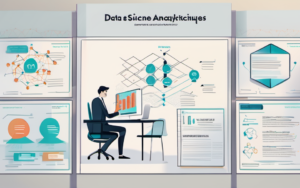Machine Learning is rapidly transforming the landscape of data science, offering powerful tools to extract insights and build intelligent systems. It’s no longer a niche area but a core component of modern data science practices, enabling solutions previously deemed impossible. Understanding how these two fields intertwine is crucial for anyone looking to leverage the power of data effectively.
1. The Intersection of Machine Learning and Data Science
1. Data Science: A Multifaceted Field
Data science is a broad discipline encompassing various skills and techniques to extract knowledge and insights from raw data. It involves data collection, cleaning, preparation, analysis, and interpretation, using statistical methods, programming, and domain expertise. Think of it as a holistic approach to understanding data, covering everything from initial data gathering to the final presentation of actionable findings. The process often involves exploratory data analysis to uncover patterns and trends before more advanced techniques are applied.
Data scientists need a diverse skillset, including strong programming abilities (often in Python or R), a solid grasp of statistical concepts, and the capacity to communicate complex results effectively to non-technical audiences. This broad skill set allows for tackling diverse problems and extracting valuable insights.
2. Machine Learning: A Powerful Tool
Machine learning, a subset of artificial intelligence (AI), provides the tools to build systems that learn from data without explicit programming. Instead of relying on pre-defined rules, machine learning algorithms identify patterns, make predictions, and improve their performance over time based on the data they’re exposed to. This “learning” process allows for automation of tasks that would be incredibly time-consuming or impossible for humans to perform manually. For example, detecting fraudulent transactions or predicting customer churn are excellent examples of tasks well-suited to machine learning.
2. Key Roles of Machine Learning in Data Science
1. Predictive Modeling
Predictive modeling is a cornerstone of many data science projects. Machine learning algorithms excel at building predictive models, forecasting future outcomes based on historical data. This can be anything from predicting customer behavior using past purchase history (how to use machine learning in data science projects) to predicting equipment failure using sensor data. Algorithms like linear regression, logistic regression, and decision trees are commonly used for this purpose. The accuracy of these models depends heavily on the quality and quantity of the training data.
2. Pattern Recognition
Machine learning algorithms are particularly adept at identifying complex patterns hidden within large datasets. This is especially useful in situations where human analysts might miss subtle correlations. For example, in image recognition, machine learning can identify patterns that classify images with high accuracy. This capability is crucial in areas like medical image analysis and fraud detection, where identifying subtle anomalies is critical. Machine learning algorithms for data analysis provide powerful tools for pattern recognition.
3. Data Exploration and Visualization
While not always directly involved in model building, machine learning can aid in the initial stages of data exploration. Dimensionality reduction techniques, for instance, can help visualize high-dimensional data more easily, revealing hidden structures and relationships. This allows data scientists to gain a better understanding of their data before diving into more complex modeling tasks. Data science with machine learning techniques offers a powerful combination for exploration and analysis.
4. Automated Decision Making
Machine learning facilitates the creation of automated decision-making systems. These systems can process vast amounts of data and make decisions more quickly and consistently than humans. This is especially useful in scenarios requiring real-time decision-making, such as algorithmic trading or fraud detection systems. Machine learning tools for data scientists are essential for building these robust and efficient systems.
3. Applications of Machine Learning in Data Science
1. Business Analytics
Machine learning is revolutionizing business analytics by providing more accurate predictions of customer behavior, optimizing marketing campaigns, and improving supply chain management. Analyzing customer data to predict future purchases or personalize recommendations are prime examples of machine learning applications in data science in this field.
2. Healthcare
In healthcare, machine learning is used for disease prediction, diagnosis support, personalized medicine, and drug discovery. Analyzing medical images to detect anomalies or predicting patient outcomes based on medical history are significant applications of machine learning in this field, improving diagnostic accuracy and patient care.
3. Finance
The finance industry leverages machine learning for fraud detection, risk assessment, algorithmic trading, and customer profiling. These applications improve security, optimize investment strategies, and enhance customer experiences.
4. E-commerce
E-commerce platforms rely heavily on machine learning for product recommendations, personalized marketing, and supply chain optimization. This enhances customer engagement and efficiency, leading to increased sales and customer satisfaction.
4. Challenges and Considerations
1. Data Quality and Preparation
The success of any machine learning model hinges on the quality of the data used to train it. Data cleaning, preprocessing, and feature engineering are crucial steps that demand significant time and effort. Poor data quality can lead to inaccurate models and unreliable results.
2. Model Selection and Evaluation
Choosing the right machine learning algorithm for a specific task is critical. Various algorithms are better suited for different types of data and problems. Rigorous model evaluation using appropriate metrics is essential to ensure the model’s accuracy and reliability.
3. Ethical Implications
As machine learning systems become increasingly sophisticated, ethical considerations become more significant. Bias in data can lead to biased models, perpetuating existing inequalities. It’s crucial to address these issues to ensure fairness and transparency.
5. The Future of Machine Learning in Data Science
1. Advancements in Algorithms
Ongoing research and development are leading to more efficient and powerful machine learning algorithms. New algorithms are constantly emerging, pushing the boundaries of what’s possible in data analysis and prediction.
2. Increased Automation
Automation in data science is likely to increase, with machine learning playing a central role. Automated feature engineering, model selection, and hyperparameter tuning will simplify the data science workflow and make it more accessible to a wider range of users.
3. Integration with Other Technologies
Machine learning is increasingly integrated with other technologies, such as cloud computing, big data platforms, and the Internet of Things (IoT). This integration enhances the capabilities of machine learning systems and broadens their applicability. This synergy promises even more innovative applications in the future. The convergence of these technologies is transforming how we approach complex data challenges. The future of machine learning in data science is bright, promising even more sophisticated and impactful applications across diverse fields.




